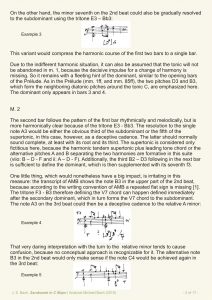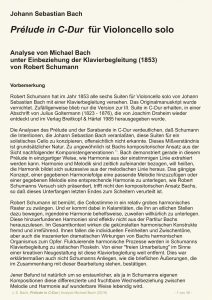Category Archives: Allgemein
Analysis Prélude in C Major for Cello solo
Johann Sebastian Bach – the Unknown
The Initials of J. S. Bach in D minor
This is a translation of the post „Die Initialen von J. S. Bach in d-moll“
by Dr. Marshall Tuttle.
This was part of a lecture within the introduction to the project
“IM KLANGSTROM” by Renate Hoffleit and Michael Bach Bachtischa
held in Ulm, Germany on December 7, 2018.
The name BACH consists of 4 note names. First of all, the German note names “h” and “b” are different in German than in English. In English the two notes are represented as “b” and “b-flat” respectively. (In this paper we will adhere to the German spelling. – translator –) In German “b” and “h” are distinct note names:
[plays “b – a – c – h”] (“b-flat – a – c – b” in English, here and in what follows.)
You can also play them in this order:
[plays “a – b – h – c”]
Or like this:
[plays “c – h – b – a”]
They are chromatic pitches each separated by one semitone.
Bach has often utilized these pitch sequences in his composition, as everyone knows, – at least every musician.
Now, in the “Chaconne” in D minor, he adds more of his name to the composition, namely the notes “g” and “es”. (“es” is the German spelling of the note “e-flat”. The translation adheres to the German spelling. – translator –) I don’t think anyone has yet grasped its meaning. Today is the first time that I am making this known. In the overall context these are special pitches.
With the “Chaconne” I first noticed that the pitches “b” and “a” are very common:
[plays “b” and “a” in different octaves.]
Most of the time they are the highest pitches or notes in the bass, so:
[plays from measure 17]
In measure 18 the notes “b” and “a” are in the upper part:
[plays up to bar 19]
You can hear this chromaticism, that is the notes “c – h – b – a” from BACH in the lower part and the notes “b” and “a” in the upper part.
This chromaticism can be found again:
[plays bars 33 to 36]
Again the chromatic sequence “c – h – b – a”.
These pitches are relatively common, because they are related to the key in D minor:
[(V7) – IV – (V7) – VI / i]
The tone “a” is the fifth of D minor:
[plays “d – f – a”]
… is the root of the dominant:
[plays “a – c-sharp – e”]
… and it is also the third of the relative major, F major:
[plays “f – a – c”]



















